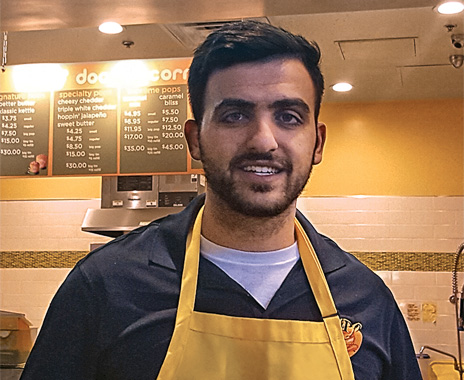Malls might not be the first place a prospective franchisee looks to when considering real estate options. But for Mohammad Mansour, the mall was exactly where he wanted to be.
After all, Mansour had already spent much of his working career inside a mall. At 16 years old, he worked at a Sbarro restaurant managed by his uncle at the Orland Square Mall in Orland Park, Illinois.
Now 25, Mansour has since gone from employee to operator—with a brief stint as a corporate accountant in between. He continues to find success with several brands inside shopping centers.
Mansour owns and operates multiple units, including the healthy soup concept Zoup!; a cobranded unit featuring Smoothie Factory and Red Mango; and two indulgent cobranded units comprised of Doc Popcorn and Dippin’ Dots—one unit is located inside the Orland Square Mall and the second is inside the Yorktown Center Mall in nearby Lombard, Illinois.
Mansour shares how franchisees can leverage the mall space—and not just the food court—to test the waters and grow their businesses.
1. Commit to the space
I was married to being in the mall when it came to becoming a franchisee. I liked the idea of increased foot traffic on a yearly basis.
Having my uncle as a mentor, I was made aware of the operational benefits and challenges when it came to the mall space. Malls do have a lot of challenges and variables that I knew I’d have to overcome, but I grew up there and shopped there. It was very much a part of my life before owning a business inside its walls.
If a franchisee has the opportunity for a mall location, the first piece of advice I would offer is to know your mall. Without having any prior knowledge, you’ll have no idea of the foot traffic, change in shopping habits from season to season, costs, or the specifics like where most people enter the mall and where most people exit.
I knew I wanted to invest a little bit more in my rent and get an in-line store inside the food court when first starting out, and that first space was Zoup!.
If you have a brand in mind, temporary leasing inside the mall is always an option. It could be a kiosk, and you might not get to choose the exact location, but it can still be a determining factor as to whether or not you’ll commit long-term. Test out the space, let customers and shoppers test out your product, and make a decision after a trial run. Kiosks provide a discount in overhead and rent, as well.
There are positives to being inside the food court, sure, but there’s a big difference when it comes to operating in a kiosk. I have two in-line stores inside the food court, as well as two freestanding kiosks. There are advantages to both.
2. Find the right brand
Knowing that I wanted to be in the mall for my franchising efforts, it ultimately came down to which brand to go with. There are some universal concepts when it comes to a mall food court: a couple burger options, an Asian-inspired concept, grilled sandwiches and fries, to name a few.
Looking at the space, I knew there would have to be something different if I were to survive. Not only different, but something with more rotating choices, and a bit healthier compared to other offerings.
Zoup was a no-brainer once I made that realization. Not only would it offer different options such as soup and a salad among burgers and fries, but it would also allow variance. Out of 12 soups on the menu each day, there are only two that remain constant. This means that there’s variance in a space that typically doesn’t get a lot of change, and I think the customers really respond to that.
It’s the same with my other cobranded concepts in Smoothie Factory and Red Mango, as well as Doc Popcorn and Dippin’ Dots. Those brands allow for not just a product, but an experience and an opportunity for families to take a break from shopping and snack together.
Just like outside the mall, location is always important when it comes to your business. Again, I wanted the prime spot in the food court for my first location, but there are benefits to being outside the court. For example, the Dippin’ Dots and Doc Popcorn location inside the Yorktown Center Mall is a kiosk in close proximity to a toy store.
There are strategic options inside the mall space that franchisees can seek out for a successful venture.
3. Don’t sweat the slow season
Even though I ditched a career in accountancy, my education would help tremendously when it came to running businesses. I was able to figure out margins quickly and where costs needed to be. This is where prospective franchisees really need to know their product. There are going to be some break-even months, but the holiday season usually makes up for them.
That being said, if you’re struggling in the busy season, it’s not going to go well in the slower months that follow. The profit margin has to be large in November and December. Otherwise, you won’t make it.
I felt that the concepts in place would provide enough variance in products offered to stay profitable throughout the year.
Malls provide loyal customers, too: other mall employees. My initial success came from building relationships with mall employees. Half of my customer base comes from mall employee sales, which come from loyalty cards, direct communication, and maintaining a relationship.
I’m constantly engaging while being inside the mall. I knew that there would be some hardships, but the right personality and product offerings can make up for the challenges that the mall presents.








